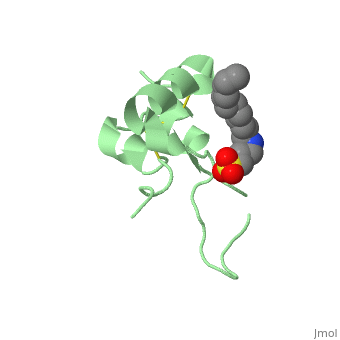IGF1
From Proteopedia
(Difference between revisions)
| Line 22: | Line 22: | ||
Its secondary structure as shown here is composed of alpha helix and beta strand. | Its secondary structure as shown here is composed of alpha helix and beta strand. | ||
[[Image:IGF1.png]] | [[Image:IGF1.png]] | ||
| - | Its 3D structure is : <Structure load=' | + | Its 3D structure is : <Structure load='3lri.1' size='350' frame='true' align='right' caption='Insert caption here' scene='Insert optional scene name here' /> |
| + | |||
| + | |||
=== Stimulating interaction : IGF1 - IGF1R === | === Stimulating interaction : IGF1 - IGF1R === | ||
IGF1R is a transmembrane protein receptor. It is composed of two alpha subunits and two tyrosine beta subunits. Both alpha subunits are cysteine-rich region and therefore linked with a disulfide bond. Ligand-binding on alpha subunit induces activation of beta subunit by autophosphorylation. It further leads to activation of the Akt and mTor pathways inside the cell. | IGF1R is a transmembrane protein receptor. It is composed of two alpha subunits and two tyrosine beta subunits. Both alpha subunits are cysteine-rich region and therefore linked with a disulfide bond. Ligand-binding on alpha subunit induces activation of beta subunit by autophosphorylation. It further leads to activation of the Akt and mTor pathways inside the cell. | ||
Revision as of 15:21, 26 January 2017
Insulin-like growth factor 1
| |||||||||||
References
- ↑ Patrick Jouandin. Rôle de la voie de signalisation Insuline dans le couplage des informations nutritionnelles et développementales au cours de l'ovogenèse chez la drosophile. Sciences agricoles.Université Nice Sophia Antipolis, 2013. Français.<NNT : 2013NICE4102>.<tel-00932409>
Proteopedia Page Contributors and Editors (what is this?)
Maxime Julliot, Alexia Kindler, Virginie Nakad, Michal Harel, Alexander Berchansky


